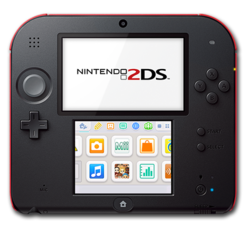From NintendoWiki, your source on Nintendo information. By fans, for fans.
Nintendo 2DS
ニンテンドー2DS
|
|
|
| Media
|
Nintendo 3DS Game Card, Nintendo DS/DSi Game Card, digital distribution
|
| Storage capacity
|
128 MB FCRAM, 6 MB VRAM, 1 GB internal flash memory, SD memory card
|
| CPU
|
Dual-core ARM11 MPCore
|
| Model no.
|
FTR-001
|
|
| Can connect with
|
Wii U, Nintendo DS
|
| Input
|
Touch Screen (stylus), ABXY buttons, D-pad, Circle Pad, shoulder buttons
|
| Backwards compatible with
|
Nintendo DS/DSi
|
| Services provided
|
Nintendo Network
|
|
| Launch date
|
WW: October 12, 2013
KR: December 7, 2013
JP: February 27, 2016
|
| Discontinue date
|
N/A
|
| Units sold
|
Worldwide: 7.42 million[1]
NA: 2.99 million[1]
JP: 590,000[1]
|
|
| Predecessor
|
Successor
|
| N/A
|
N/A
|
|
The Nintendo 2DS is the second alternative model of the Nintendo 3DS hardware. The system is an entry-level, budget model of the hardware, being priced at a lower point than the other models, and makes several changes to the hardware to do so, most notably, as the name implies, the lack of stereoscopic 3D, and the different form factor. Because of the lower price and lack of 3D effect, the Nintendo 2DS is primarily targeted at younger players, as Nintendo recommends that users under seven not use the 3D effect. The handheld was released in most regions on October 13, 2013, alongside Pokémon X and Y; in Japan it was released on February 27, 2016, alongside the Virtual Console re-releases of Pokémon Red, Green, Blue, and Yellow Versions.
Features
While the Nintendo 2DS uses the same hardware and firmware as other Nintendo 3DS family systems, and retains most features of the system, many other changes have been made to reduce the price of the system. One of the biggest changes is the form factor, as the Nintendo 2DS does not use the "clamshell" design used since the Nintendo DS, instead opting for a "slate" design. For the "dual screens" effect, the system actually uses a singular, non-stereoscopic touch display, framed to have the same dimensions as the Nintendo 3DS's screens and still only allowing for touch actions on the "bottom screen".
While the button layout is mostly similar to the other models, the buttons are positioned closer to the center, the Start and Select buttons are beneath the face buttons instead of being on both sides of the HOME Button, and the Power button is on the bottom of the system. The headphone port is moved to the right side of the system, while on the left side is a Sleep switch that puts the system into Sleep Mode, as the hardware cannot shut to engage Sleep Mode like the other models. Finally the system uses a singular, mono speaker as opposed to the dual stereo speakers on other models, though stereo audio is enabled when using headphones. The Wireless switch has also been replaced with a toggle accessed through the HOME Menu's options.
Pictures taken with the Nintendo 2DS camera can still be viewed in 3D when viewing on a stereoscopic 3D-compatible system.
Games
The Nintendo 2DS is compatible with all games that can be played on other standard Nintendo 3DS models. However, these games cannot be played in stereoscopic 3D. The system also keeps backwards compatibility with Nintendo DS and Nintendo DSi games.
Accessories
The Nintendo 2DS is compatible with most accessories released for other models, such as the AC Adapter and stylus. However, it is incompatible with accessories such as the Charging Cradle and Circle Pad Pro due to its different design.
External links
References

|
This article is a stub. You can help NintendoWiki by expanding it.
|
|
|
|
|
|
|
| Other
|
| Standalone consoles
|
Arcade
|
Pokémon
|
Classics
|
Cancelled
|
|
|
|
|
|
|
|


